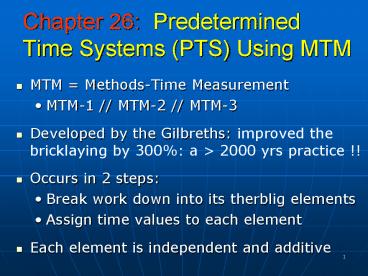Chapter 26: Predetermined Time Systems PTS Using MTM PowerPoint PPT Presentation
1 / 13
Title: Chapter 26: Predetermined Time Systems PTS Using MTM
1
Chapter 26 Predetermined Time Systems (PTS)
Using MTM
- MTM Methods-Time Measurement
- MTM-1 // MTM-2 // MTM-3
- Developed by the Gilbreths improved the
bricklaying by 300 a gt 2000 yrs practice !! - Occurs in 2 steps
- Break work down into its therblig elements
- Assign time values to each element
- Each element is independent and additive
2
MTM-1
- Most detailed system
- Motions are broken into 10 categories
- Times are found in Tables 26.1-26.11
- Distance, complexity, and/or weights are taken
into consideration
- MTM Categories
- Reach
- Move
- Turn
- Apply Pressure
- Grasp
- Position
- Release
- Disengage
- Body Motions
- Eye Motions
3
Methods Analysis and Time
- Reference Karger, D. Bayha, F. Engineered
Work Measurement, 4th edition. New York, Ind.
Press 1987. - Time is given in time measurement units
(TMUs) - 1 TMU 0.000 010 h 0.000 600 min 0.036 s
- -Or-
- 1 s 27.78 TMUs
- 1 min 1,667 TMUs
- 1 hr 100,000 TMUs
No Allowances Included
4
MTM-2 and MTM-3
- Fewer types of motions than MTM-1 therefore are
easier to use - Fewer cycles needed in order to study the process
- MTM-1 requires 250 cycle times
- MTM-2 requires 100 cycle times
- MTM-3 requires 35 times
5
REACH Table 26.1
Distances Motion path of hand knuckle or finger
tip. Body assistance (shoulder movement or
pivoting) not included. Interpolation is
suggested R15A Acceleration
Deceleration Hands could be in motion at the
beginning and end of the cycle. Then Acc.
Decel. can be omitted. Double this decrease is
subtracted (Hand in Motion Table 26.2)
MOVE Table 26.2 Hand is usually
holding something (or pushing and dragging an
object. Three cases are considered (nature of
their destination).
6
Methods Analysis and Time
Movements can be refined to consider the effect
of acceleration or Dec., or both. Also considered
as a refinement for Object weight resistance to
movement. MTM Both Moves and Reach are
influenced by motions preceding
or following them Nomenclature Accel. - Decel.
If omitted we use m mM6B or M6Bm Weight
Included up to 2.5 lb/hand If two
hand used, and object is 5lb, no extra
time is allocated.
7
Methods Analysis and Time
Sliding Takes the Object Weight ? ?
(wood-wood wood-metal 0.4, metal-metal
0.3) Example M6B 8.9 a 5lb weight
object (T-26.2) M6B5 8.9 ? 1.06
2.2 11.8 Dynamic Factor
Static Constant Weight of Additional
Components To gain control
through dynamic component for
extra Travel Time.
8
Methods Analysis and Time
TURN (Table 26.4) Considers the rotation
of the hand, wrist and forearm about long axis of
forearm Time f(?,weight,
resistance to ?) APPLY PRESSURE (Table
26.5) Is the application of force without
resultant move APA Basic element APB
APA Regrasp Grasp Position
Disengage Release
Time Reducers
Skill Motions
9
Methods Analysis and Time
GRASP (Table 26.6) To gain Control of an
object or Objects (followed by a move). Considers
5 Types Type 1 Pick-up Grasp Follows an A
or B reach Type 2 Regrasp Performed during a
move limited-out Type 3 Transfer Grasp Control
from 1 hand to the other Type 4 Jumbled Grasp
Follows a C reach Type 5 Contact, sliding or
hook Grasp Between a Reach a Move POSITION
(Table 26.7) Collection of minor hand
movements (less than 1 inch) for aligning,
orienting, engaging 1 object with another.
10
Methods Analysis and Time
Align Orient longitudinal axes of the two
items. Orient Rotation about long axis to align
mating features (key in a lock,
for example). Engaging Move along longitudinal
axis to mate the parts Disengage Complement of
the engage portion position Assumption
Alignement Orientation are done t
0 Position Times Table
26.7 They are a function of Pressure to Fit,
Object Symmetry, Ease of Handling
11
Methods Analysis and Time
- 3 Classes of Fit (Table 26.8)
- Loose Gravity will do it, code 1
- Close Light pressure needed (1 APA), code 2
- Tight Heavy pressure needed (3APAG2), code3
- 3 Classes of Symmetry (Table 26.8)
- Symmetrical (Code S) No matter the orientation
no rotation is needed for assembly (peg in round
hole) - Non-Symmetrical (Code NS) There is one and
only one orientation in which the parts will
mate. - Semisymmetrical Any position that is not S or NS
- Example A
turn of 45
12
Same rules as MODAPTS
- Need experienced operator and experienced
practitioner - Allowances are applied separately
- Will need to measure certain number of cycles in
order to get statistically significant sample
13
Plus Some Additional Rules
- Must be repetitive work, not occasional
- Distances (or degrees or other qualifying codes)
determine time elements - Tables must be present in order to get correct
time per element - Additional weight (or symmetry or other
penalties) may be applied

